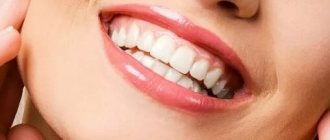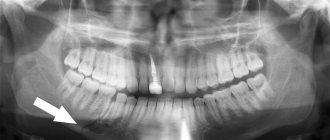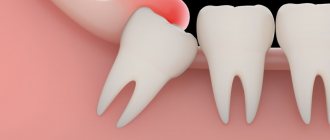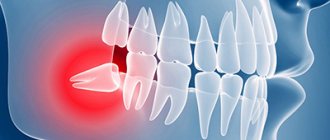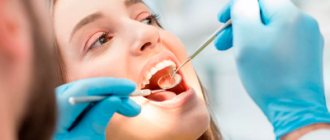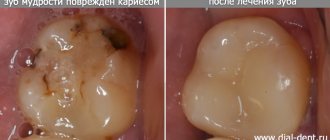Reasons for the formation of pus in the gums
There are several reasons for the formation of pus:
- The inflammatory process causes a disease such as periodontal disease (gingivitis).
- Periodontal disease.
- Mechanical damage to the gums.
- Chemical or thermal burn.
- Unprofessional removal of tartar, which affected the gums.
- Extensive caries causes pulpitis.
- Failure to comply with hygiene standards when performing dental procedures.
- Unsanitary oral cavity.
- Types 1 and 2 diabetes mellitus.
- Summing up the causes of purulent inflammation of the gums, we can highlight the main factor that causes this disease – the vital activity of pathogenic microorganisms.
What to do if the gums above the wisdom tooth are inflamed?
- Clean thoroughly, even if it bleeds and hurts. After all, as you already know, the cause of inflammation is that plaque and food debris around the “eight” were regularly not cleaned. The plaque microbes did their job - pericoronitis occurred. To more successfully clean plaque around a wisdom tooth, it is better to purchase a brush with elongated front bristles.
Brush with extended front bristles
- Make salt baths (dissolve 1 teaspoon of salt in 1 glass of water at room temperature - never hot!). It is recommended to put the saline solution in your mouth and hold it on the side of the inflamed tooth for several minutes. Such baths are carried out every hour; it is optimal to alternate them with rinsing with chlorhexidine.
- If the swelling does not decrease within a day or two, it is better to consult a dental surgeon. Perhaps an incision (pericoronarotomy) and the prescription of antibacterial and anti-inflammatory drugs are needed. If you have a fever and it hurts to swallow, you can’t hesitate, you need to urgently go to a dental surgeon!
- If inflammation of the gums around the wisdom tooth occurs regularly and you have repeatedly visited the dentist for an incision in the gum area above the wisdom tooth, this is an indication for removing the “eight”. Surgeons recommend removing the tooth as planned, not during an exacerbation or during an active inflammatory process. Such removal will be easier for you, painless and the body will need much less time to recover.
After reading the article, did you remember your torment with the eruption of wisdom teeth? We invite you to a consultation with a dental surgeon at the KANO clinic network. Our specialists will prescribe the necessary diagnostic X-ray and tell you what to do with the problem “eight”.
Signs of pus and purulent inflammation
- severe pain in the area of the wisdom tooth; when you press on the gum, pus is released;
- redness of the gums and swelling;
- a large carious cavity is filled with softened soft tissue;
- colored plaque on the tooth and tartar;
- enlarged lymph nodes;
- change in facial contour. It becomes asymmetrical.
What problems can arise from wisdom teeth?
- Due to the fact that the tooth is located far in the dentition, it is difficult to properly clean it of plaque and food debris. As a result, caries occurs, and then quickly becomes complicated into pulpitis. Anyone who knows pulp pain will not confuse it with anything.
- Wisdom teeth often do not have enough space in the jaw, causing them to grow sideways or even towards the second molar (seven), permanently damaging it.
- Another complication is the formation of a cyst in the area of the erupting wisdom tooth. This cyst grows quite rapidly, which leads to rapid destruction of bone tissue. Its presence on an x-ray is an absolute indication for wisdom tooth removal.
- In the absence of space for eruption, the “figure eight” crowds and shifts adjacent teeth, causing them to become crowded and crooked in position. For this reason, the eruption of wisdom teeth can lead to treatment with braces or aligners even for a person with previously completely straight teeth.
- If the wisdom tooth has not fully erupted, but is partially hidden under the gingival (mucous) hood, pericoronitis (pericoronitis) occurs. This is the name for inflammation of the gums around an under-erupted wisdom tooth.
Treatment
Treatment is prescribed after a visual examination of the oral cavity and determination of the source of pus. Treatment of purulent inflammation can be:
- In a therapeutic way with the help of medicinal drugs.
- Physiotherapeutic.
- Surgery.
If purulent discharge does not stop after a course of therapeutic treatment, the doctor will prescribe surgery. Before the operation, plaque and tartar are cleaned and the mouth is disinfected.
An injection with a local anesthetic is injected into the gum and the gum is cut. The gum mucosa is cleaned of pus. If the fistula through which pus flowed is large, then a drainage is inserted. In the postoperative period, the patient is prescribed therapeutic treatment, which includes taking antibiotics and rinsing the mouth with a 0.05% chlorhexide solution, and is prescribed a complex of vitamins and minerals.
Every day, until complete healing, the patient must come to the dentist, where he is given an antibacterial application on the gum of the wisdom tooth. The patient must strictly follow all the dentist’s recommendations for oral care and consume only liquid foods.
Does tooth decay stink?
Often people turn to specialists with an already advanced disease, and at this stage of caries a persistent, unpleasant odor from the mouth appears. Indeed, in the initial stages, a person has no idea about the problem unless he regularly visits a doctor - the process of destruction occurs gradually, and carious cavities are initially small and located inside the tooth. Meanwhile, bacteria act, increasingly destroying dentin. It happens that this condition lasts up to several years when chronic, and an unpleasant odor may emanate from the person. Many people learn about bad breath from others.
Symptoms of tooth decay
The process of rotting under the crown proceeds unnoticed and painlessly, because the nerves have been removed. Painful sensations appear later, when the inflammatory process spreads to the gums, and this is a step towards the loss of “neighboring” completely healthy dental units. Immediate consultation with a dentist is necessary if you notice:
- the appearance of a gap between the crown and gum;
- small particles of food getting under the denture;
- an unpleasant odor that reappears even after comprehensive cleaning and rinsing with an antiseptic;
- blackening of the base of the tooth.
Things to remember:
Tooth destruction is irreversible; even a highly qualified specialist cannot restore its natural integrity. And a timely visit to the dentist will certainly help to avoid complications.
Final provisions
When a doctor diagnoses pericoronitis, it means that the gums around the erupting teeth - permanent or baby - have become inflamed, and the tooth is probably not growing properly. The abnormality creates a pocket called a hood between the new tooth and the soft tissue. The cavity quickly fills with a substrate consisting of plaque and bacteria, and decay begins. The main symptom is pain at the site of the growing tooth; in addition, other signs are present.
Pericoronitis is treated by removing the inflamed soft tissue (hood), or extracting the tooth (in extreme cases). Home methods, rinses, lotions will not help, they can only do harm if you rely on them completely and do not visit the hospital.
Treatment of pericoronitis can be quick - in the early stages, and long and painful - in advanced stages. A person can prevent the development of pathology while complying with hygiene standards. And it is worth remembering that modern dentistry is a very rapidly developing branch of medicine. Trust the professionals to help you maintain your health.
Dental treatment without a drill, placing a filling without drilling in Moscow
Mistakes and complications in the treatment of dental pulpitis
Dental treatment during pregnancy 2nd trimester
Restoration of tooth enamel, price, drugs
Dental treatment without pain in Moscow
Treatment of dental caries using the Icon method without preparation
Repeated endodontic treatment of tooth canals for pulp inflammation
How to remove an unpleasant odor: eat right
In addition to hygiene measures, you need to follow some additional ways to eliminate halitosis from caries, for example, eat right, avoiding the consumption of certain junk foods. Avoid spicy or strong-smelling foods (onions, garlic, spices), tobacco and alcohol. They definitely don't promote fresh breath, making the problem worse.
Doctors also advise drinking more water if you have tooth decay to remove bad breath. The liquid washes away bacteria and plaque that cause the spread of unpleasant odor.
When trying to find a way to get rid of smell from caries, do not forget that it can be caused by other reasons, for example, gastrointestinal diseases or infections - it is not always the carious process that leads to unpleasant odor from the oral cavity.
Is it possible to get rid of the smell of caries?
Unfortunately, it will not be possible to completely eliminate the smell of current caries until the disease is completely cured, because cariogenic bacteria will continue to destroy the tooth. If it is not in a too advanced stage, it is possible to reduce the intensity of the smell during caries. You must adhere to certain rules. Here's what experts advise in this case.
Regular cleaning
It is advisable to brush your teeth after every meal. However, this should not be done immediately, but approximately 20-30 minutes after eating. The minimum number of cleanings is two per day. Remember that brush movements should be vertical, from top to bottom and vice versa. It is better to select the bristles of the brush that are not too hard, and carry out the process for at least two minutes. You can use a toothpaste with sodium bicarbonate, which actively eliminates the buildup of caries bacteria along the gum line.
Using rinse aids
After brushing your teeth, use an additional mouthwash. Many of them contain essential oils of menthol, thymol, eucalyptus, and methyl salicylate. They effectively prevent the formation of microbial plaque on the surface of teeth and destroy bacteria that provoke their destruction. The mouthwash removes odor for a while and is also a good preventative against gum and dental diseases.
Flossing
This method is especially relevant when the structure of the teeth is such that food often gets stuck between them. It is especially convenient to use dental floss (floss) and then mouthwash in the workplace - brushing your teeth in the office bathroom is not always inconvenient. It is the leftover food that bacteria feed on, then causing the process of rotting and the corresponding smell.
Tongue cleaning
This is important to do in case of dental diseases, when plaque forms on the tongue, which also spreads an odor, including caries. Daily care of your tongue, along with your teeth, cleans it of bacteria and also helps:
- get rid of bad breath for a while;
- remove plaque in which bacteria multiply;
- avoid the active development of caries, preventing microorganisms from destroying teeth.
In addition, a clean tongue perceives the taste of food and drinks much better. For this procedure, special accessories and products are sold: gel, scraper, attachment for a brush or for an irrigator. With their help, you can effectively and gently cleanse your tongue of plaque to reduce the risk of bad breath.
